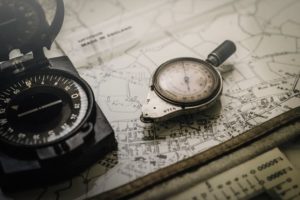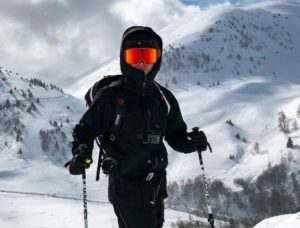Whether you’re taking a leisurely hike to a favourite waterfall or attempting a challenging peak, having the right kit is vitally essential for success. If anything goes wrong, as it always will, this may be the difference between a small annoyance and a disastrous outcome. A critical component of any pre-trip preparations, whether you’re a first-timer or an old hand at wilderness travel, is getting your basic day hiking gear dialled in.
It is a good practice to have the Eleven best accessories for hiking with you every time you go into the wilderness, even for a day trek. True, on a normal journey, you may just utilise a few of them, or none at all, depending on your needs such as hiking gear and others. When anything goes wrong, it’s only then that you’ll realise how important it is to have these materials on hand in case they become necessary for your life.
Table of Contents
Navigation

Navigation is essential for any trek into the wilderness, and a topo map and a dependable compass are two tools that should be brought along with you at all times. They’re dependable, lightweight, and long-lasting, and they’re guaranteed to never run out of power. They may prevent you from being disoriented or assist you in regaining your bearings, but they are useless if you do not understand how to utilise them. Learn how to use a map and compass, as well as how to avoid being disoriented, before embarking on your next adventure. We also suggest that you store your maps in a transparent, water-resistant map pouch to keep them dry and safe while travelling.
GPS devices and phone applications (GAIA, TopoMaps, and so on) are wonderful tools for augmenting a map and compass, even though they are not strictly included in the 10 accessories List. If you want to use GPS frequently, you may want to consider carrying a power bank in case your gadget runs out of battery power. While GPS devices may be very handy and helpful on the route, they should never be relied on to completely replace your map and compass on the trail.
Personal locator
Personal locator beacons (PLBs) and satellite messengers are devices that may be used to inform emergency services if you need assistance when out in the wilderness. When triggered in an emergency, they will use GPS to detect your location and transmit a message through government or commercial satellites to the appropriate authorities. A personal locator beacon (PLB) or satellite messenger may be a useful backup in case anything goes wrong, and they can be used in distant areas where a mobile phone cannot be relied upon to have a working signal.
Lamp

You must always carry a light source as vital hiking accessories with you if you want to be able to navigate your way across the woods at night. A headlamp is the favoured lighting option for most wilderness hikers since it frees up your hands for a variety of duties, such as preparing supper or gripping trekking poles.
Insulation
Because the weather may change fast on any wilderness excursion, we always suggest having an additional layer of insulation clothing – even on outings in warm weather – with you. The use of a basic layer-able, quick-dry clothing system will keep you safe and toasty when the temperatures fall. For example, we bring a down hooded jacket and rain protection with us on practically every hiking excursion, regardless of the weather predictions.
As soon as you come to a complete halt on your hike, your wet garments will swiftly freeze you to the bone. More information may be found in our article on how to develop a layering strategy for hiking.
Protection from sun
Always bring extra hiking clothes and accessories, as well as sunglasses, sun-protective gear, and sunscreen. In the near term, failure to do so may result in sunburn and/or snow blindness; in the long term, it can result in accelerated skin ageing, skin cancer, and cataracts.
Sunglasses

When spending time outside, high-quality sunglasses are a must to protect your eyes from potentially harmful radiation. If you’re going to be travelling for an extended period on snow or ice, you’ll need exceptionally dark glacier glasses. All of the sunglasses supplied by REI block 100 per cent of ultraviolet radiation (UVA and UVB), which is a critical feature of high-performance lenses. The formation of cataracts has been connected to exposure to ultraviolet B rays, which are the rays that may burn your skin.
First aid kit

It is critical to have a first-aid kit as hiking equipment on hand and to be familiar with how to utilise the materials in it. Pre-assembled first-aid kits take the guesswork out of putting together your own, while many individuals modify these kits to meet their wants and requirements. Blister treatments, adhesive bandages of different sizes, multiple gauze pads, adhesive tape, disinfecting ointment, over-the-counter pain medicine, a pen, and paper should all be included in any blister kit you put up.
Gloves made of nitrile should also be supplied. The contents of your pack will be influenced by the duration of your journey and the number of individuals that will be participating. It’s also a good idea to have a little handbook on dealing with medical crises on hand at all times.
Knife
Knives can be very helpful for a variety of tasks like gear maintenance, food preparation, first aid, kindling, and other emergency requirements, making them an absolute must for any expedition. Every adult in your party should have a knife in their possession.
Rather than a single foldout blade, a more complicated knife or multitool may have one or two flathead screwdrivers, a can opener, and/or a pair of foldout scissors in addition to the blade. The more complicated your requirements (for example, if you are in charge of a group of unskilled participants), the more choices you may need in your knife or tool.
Extra water

Having adequate water for your adventure is essential, as is having some means of cleaning the water you encounter on your journey. This might be in the form of water filters, chemical treatment, or even a furnace for melting snow in colder climates. Take into consideration that most persons need around a half litre of water each hour of moderate exertion in moderate conditions when considering how much water to carry.
Depending on conditions such as the ambient temperature, altitude, amount of activity, or the nature of the situation, you may need to carry more than that. As a starting point, always be sure to have at least one water bottle or a collapsible water reservoir with you. Pour water into your water bottle or reservoir before you start hiking from a potable water source.
Nutrition’s
In order to prepare for a trek, you’ll want to make sure that you pack along enough calories to keep your energy levels up for the duration of the journey. While hiking, we often consume energy bars, dried fruits, almonds, and beef jerky as snacks. We prefer to carry tortillas or bagels and assemble sandwiches with hard meats (such as salami) and cheeses for a more substantial lunch.
Toiletries

A cathole at least 6-8 inches deep is required for proper waste disposal, and if you don’t bring a trowel (we now use this inexpensive and lightweight snow stake), you won’t be able to dig one that deep before you leave the house! That’s all there is to it. Either bury your TP or place it in a Ziploc bag when you’re done using it.














